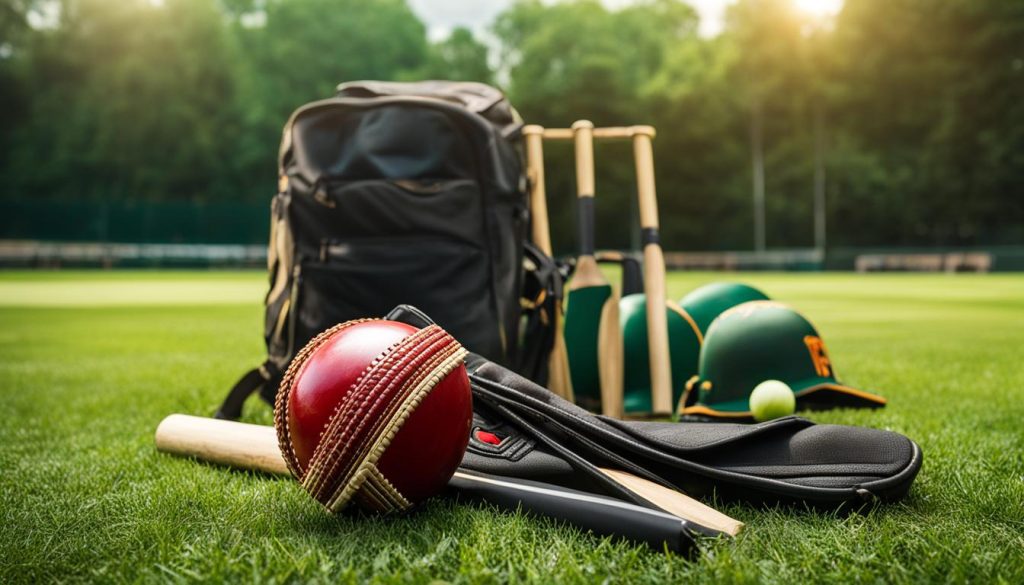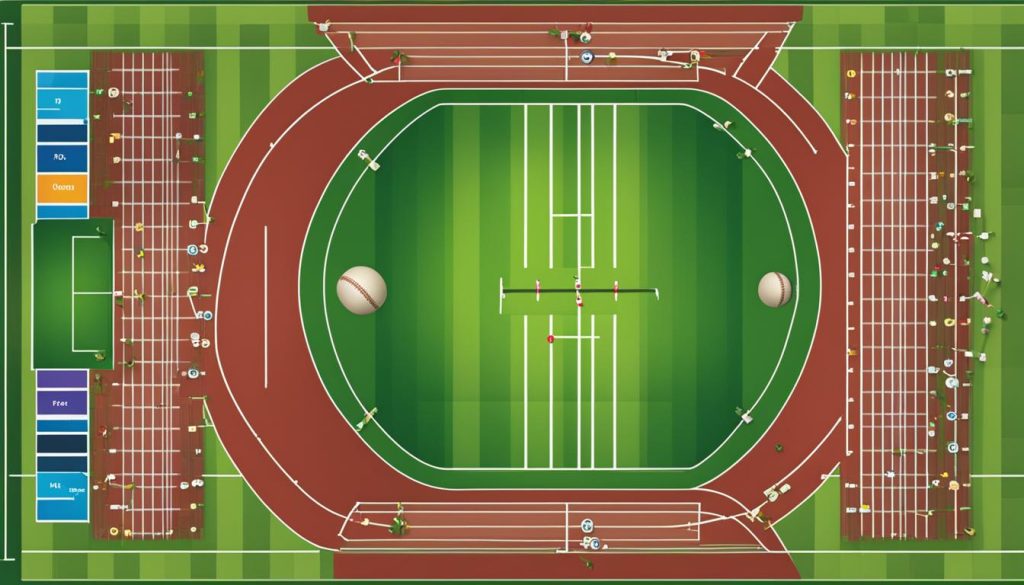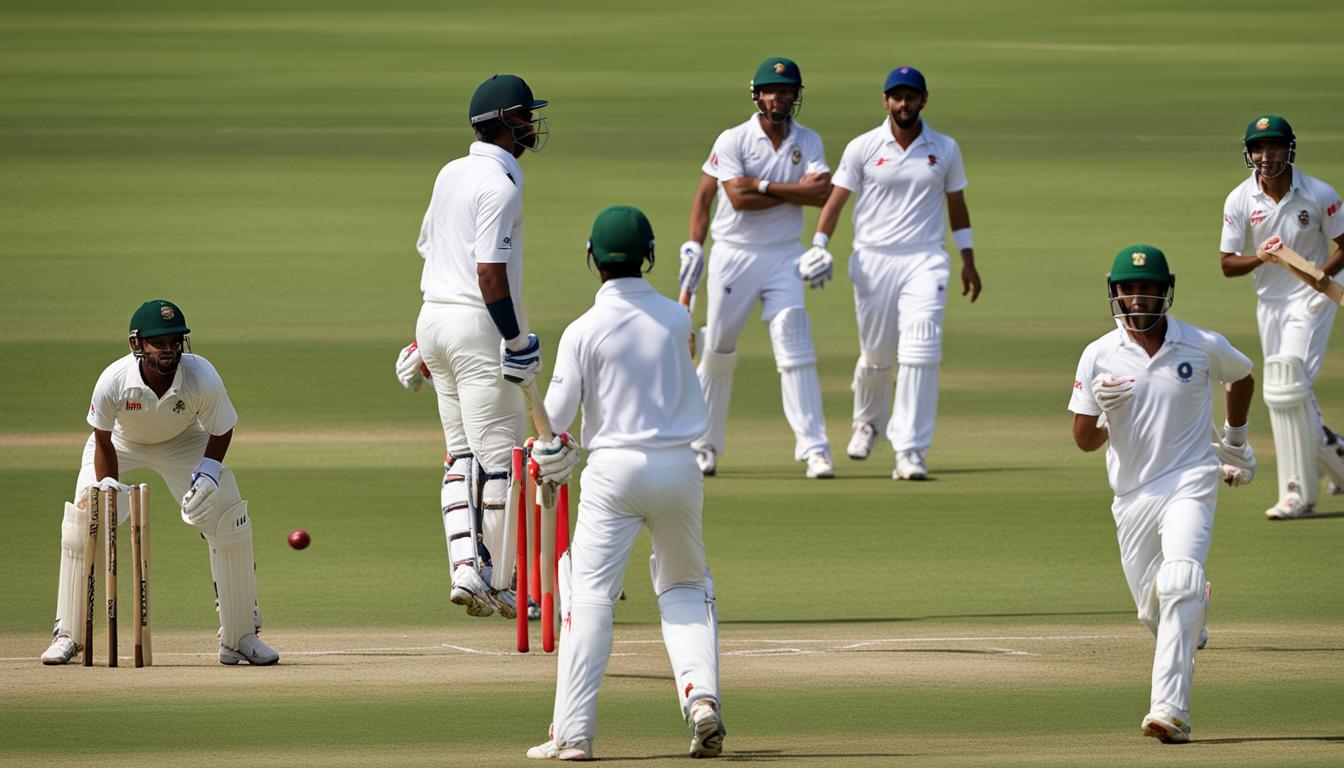Have you ever wondered what all the buzz is about when it comes to cricket? This popular sport has captured the hearts of millions around the world, but what is cricket exactly and how is it played? Whether you’re a beginner curious to learn about the game or simply looking to brush up on your knowledge, we’ve got you covered.
Cricket is a team sport played by two competing sides, usually formed of 11 players each. It can be played anywhere, from a park or garden to a street or beach.

The game takes place on a cricket ground, a large expanse of flat grass with a circular or oval shape. The pitch, located in the middle of the field, is a vital element of the game.
But what happens on the pitch? How do teams score runs? And what are the different formats of cricket? In this article, we’ll delve into the key elements of cricket, from its history and rules to the equipment needed and ways to be dismissed. Get ready to unlock the secrets of this captivating game!
Key Takeaways:
- Cricket is a team sport played by two sides with 11 players each.
- The game is played on a cricket ground with a circular or oval shape.
- The pitch is situated in the middle of the field and is key to the game.
- Teams score runs by running between the wickets or hitting boundaries.
- Cricket has different formats, including Twenty20, one-day fixtures, and Test matches.
Types of Cricket Formats You Can Play
Cricket is a versatile sport that can be adapted to suit any space and accommodate players of various ages and abilities. Whether you have a large field or a small backyard, there are different cricket formats you can play.
The three popular cricket formats that offer exciting gameplay are:
- Lords Game
- Continuous Cricket
- Pairs Cricket
In the Lord’s game format, teams take turns to bat and field. The batting team aims to score the most runs, while the fielding team aims to dismiss the batsmen and prevent runs. This format is commonly played in longer matches and tournaments.
In continuous cricket, the game is played with a time constraint, usually a fixed number of overs per innings. Each team gets a specific number of overs to bat and score runs, and the team with the highest total wins. This format is often used in shorter matches, such as day-night games or limited-overs contests.
Pairs cricket is a variation of the game that involves pairs of batsmen playing together. Each pair faces a set number of overs and aims to score the highest number of runs. This format is ideal for youth cricket and encourages teamwork and partnership building.
Cricket formats can be adjusted to cater to players of all ages and abilities. For adults, there are formats that mimic professional games. For children, modified rules and equipment ensure an enjoyable experience while learning the fundamentals of the game.
Whether you’re a seasoned player or just starting, finding a cricket club near you can be the first step to getting involved in the game. Use the club finder tool to locate the nearest cricket club in your area and join the cricketing community.
Cricket Equipment You Need to Play
When it comes to playing cricket, having the right equipment is essential. Whether you’re interested in hard-ball cricket or a casual game of soft-ball cricket, here are the cricket equipment you’ll need:
If You Want to Play Hard-Ball Cricket:
- Bat: A sturdy and well-made cricket bat is crucial for hitting the ball with precision and power.
- Ball: A high-quality cricket ball, typically made of leather, is used for delivering fast and spin bowling.
- Helmet: Protecting your head is paramount in the game of cricket. A helmet will provide you with the necessary safety.
- Pads: Leg pads shield your legs from potential injuries caused by fast bowlers.
- Gloves: Batting gloves offer grip and protection for your hands while batting.
You can find all the cricket equipment mentioned above at major sports shops and online cricket stores.
If You Prefer Casual Games of Soft-Ball Cricket:
Apart from the hard-ball cricket equipment, casual games of soft-ball cricket require minimal gear. All you need to enjoy a fun game of soft-ball cricket is comfortable clothing, energy, and enthusiasm. So gather your friends, put on your favorite sports apparel, and get ready for a fantastic time on the field!

Remember, having the appropriate cricket equipment enhances your game and ensures safety. So, whether you’re playing competitively or recreationally, gear up and enjoy the thrilling sport of cricket!
Ways to Be Dismissed in Cricket
In cricket, there are numerous ways a batsman can be dismissed. Let’s explore the ten methods of dismissal and their specific criteria and rules:
- Caught: When a fielder catches the ball hit by the batsman before it touches the ground.
- Bowled: When the bowler bowls the ball, and it hits the stumps without the batsman making contact.
- Out leg before wicket (lbw): When the ball hits the batsman’s leg before hitting the bat, and the umpire deems it would have hit the stumps if the leg wasn’t in the way.
- Run out: When a fielder hits the stumps with the ball when the batsman is outside the crease while attempting a run.
- Stumped: When the wicketkeeper removes the bails while the batsman is outside the crease and not attempting a run.
- Hit wicket: When the batsman accidentally knocks the stumps with their bat or any part of their body while attempting to play a shot.
- Handled/ling the ball: When the batsman intentionally touches the ball with their hand without the permission of the fielding side.
- Double hit/hitting the ball twice: When the batsman deliberately hits the ball twice to prevent it from hitting the stumps or to gain an advantage.
- Obstructing the field: When the batsman obstructs a fielder’s attempt to run them out or catch the ball.
- Timed out: When the incoming batsman takes longer than three minutes to arrive after the fall of the previous wicket.
Each method of dismissal has its own significance in the game of cricket and contributes to the strategy and excitement on the field.
Refer to the following table for a quick overview of the ten ways to be dismissed in cricket:
| Dismissal Method | Description |
|---|---|
| Caught | Fielder catches the ball hit by the batsman before it touches the ground. |
| Bowled | Bowler hits the stumps without the batsman making contact. |
| Out Leg Before Wicket (LBW) | Ball hits the batsman’s leg before hitting the bat, and the umpire deems it would have hit the stumps if the leg wasn’t in the way. |
| Run Out | Fielder hits the stumps while the batsman is outside the crease attempting a run. |
| Stumped | Wicketkeeper removes the bails while the batsman is outside the crease and not attempting a run. |
| Hit Wicket | Batsman accidentally knocks the stumps with their bat or body. |
| Handled/Ling the Ball | Batsman intentionally touches the ball with their hand without the permission of the fielding side. |
| Double Hit/Hitting the Ball Twice | Batsman deliberately hits the ball twice. |
| Obstructing the Field | Batsman obstructs a fielder’s attempt to run them out or catch the ball. |
| Timed Out | Incoming batsman takes longer than three minutes to arrive after the fall of the previous wicket. |
Basic Rules and Regulations of Cricket
Cricket is a team game played between two teams of 11 players each. The game involves five basic equipment – the ball, bat, wickets, stumps, and bails. Matches are usually played on a circular or oval-shaped ground with a 22-yard pitch in the center. Each match is divided into separate sections called balls, with six balls making up an over. Different forms of cricket have different numbers of overs per innings.
During the innings, the batting team has two batsmen on the pitch, while the fielding team has players spread across the field as fielders. There are specific fielding restrictions based on cricket forms. Penalty balls, such as no balls, wide balls, and dead balls, have specific rules. Runs are scored by hitting the ball and running or hitting boundaries. Games are won based on the team with the highest number of runs.
There are various ways a batsman can be dismissed.
| Dismissal Type | Description |
|---|---|
| Caught | The batsman hits the ball, and a fielder catches it before it touches the ground. |
| Bowled | The bowler hits the wicket with the ball, and the wickets are dislodged. |
| Leg Before Wicket (LBW) | The bowler delivers a ball that would have hit the wickets, but the batsman uses their leg to protect themself. |
| Run Out | The fielding team successfully removes the bails from the wicket while the batsman is running between the wickets. |
| Stumped | The wicketkeeper removes the bails from the wicket while the batsman is out of their crease. |
| Hit Wicket | The batsman unintentionally hits the wicket with their bat or body while attempting to hit the ball. |
| Handled the Ball | The batsman deliberately touches the ball with their hand without permission from the fielding team. |
| Double Hit/Hitting the Ball Twice | The batsman hits the ball twice without the fielding team getting a chance to play. |
| Obstructing the Field | The batsman prevents the fielding team from making a play by obstructing their movement. |
| Timed Out | The incoming batsman takes too long to get to the crease, and their time expires. |
Each method of dismissal has specific criteria and rules. These rules and regulations ensure fair play and maintain the integrity of the game.

Understanding Cricket Scoring and Winning Matches
In cricket, teams score runs by the batsmen hitting the ball and running to the other end of the pitch. This continuous back-and-forth running helps accumulate the team’s runs. However, runs can also be scored by hitting the ball over the boundary. If the ball hits the ground inside the boundary, it results in a four-run score, while if it goes over the boundary without hitting the ground inside, it is awarded six runs.
Additionally, teams can earn extra runs based on specific circumstances during the game. For instance, if the bowler bowls a no ball or a wide ball, the batting team receives additional runs. These extra runs can make a significant difference in the overall score.
The team that scores the highest number of runs at the end of the match emerges as the winner. To win, teams must not only focus on scoring runs but also on restricting the opposing team’s runs. The team’s bowling and fielding performance play essential roles in achieving this. In addition to scoring runs, matches are won by dismissing the opposition players through various methods like catches, run-outs, or bowling them out.
In various formats of cricket, different strategies and tactics are employed to secure a victory. For example, Test matches, which span multiple days, require teams to balance their batting and bowling strengths over extended periods. On the other hand, shorter formats like Twenty20 and one-day matches demand quick run-scoring and aggressive gameplay.






